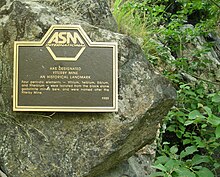Ytterby Pit
The Ytterby mine is a former mine in the Swedish municipality of Vaxholm on the island of Resarö in the Stockholm archipelago .
The Ytterby mine played an important role in the history of the discovery of the rare earth elements , as many of them were first found here; so gadolinium (named after the Finnish chemist Johan Gadolin ), holmium (from the Latin name for Stockholm), thulium ( Thule is an old word for Scandinavia ) and yttrium , ytterbium , terbium and erbium , all of which were named after Ytterby.

Yttrium (Y) and terbium (Tb) were discovered in 1843 by the Swedish chemist Carl Gustav Mosander . In 1878 the Swiss Jean Charles Galissard de Marignac discovered ytterbium (Yb), and in 1879 the Swedes Per Teodor Cleve and Lars Fredrik Nilson discovered the elements erbium (Er), holmium (Ho) and thulium (Tm).
Today the Ytterby deposit is largely depleted.
In 1989 ASM International found the mine to be an important site for the discovery of metals and added it to the list of Historical Landmarks . A corresponding plaque was placed at the entrance to the pit.
Individual evidence
- ^ ASM Historical Landmarks. ASM International, accessed July 2, 2017 .
Coordinates: 59 ° 25 ′ 35.4 ″ N , 18 ° 21 ′ 12.7 ″ E

